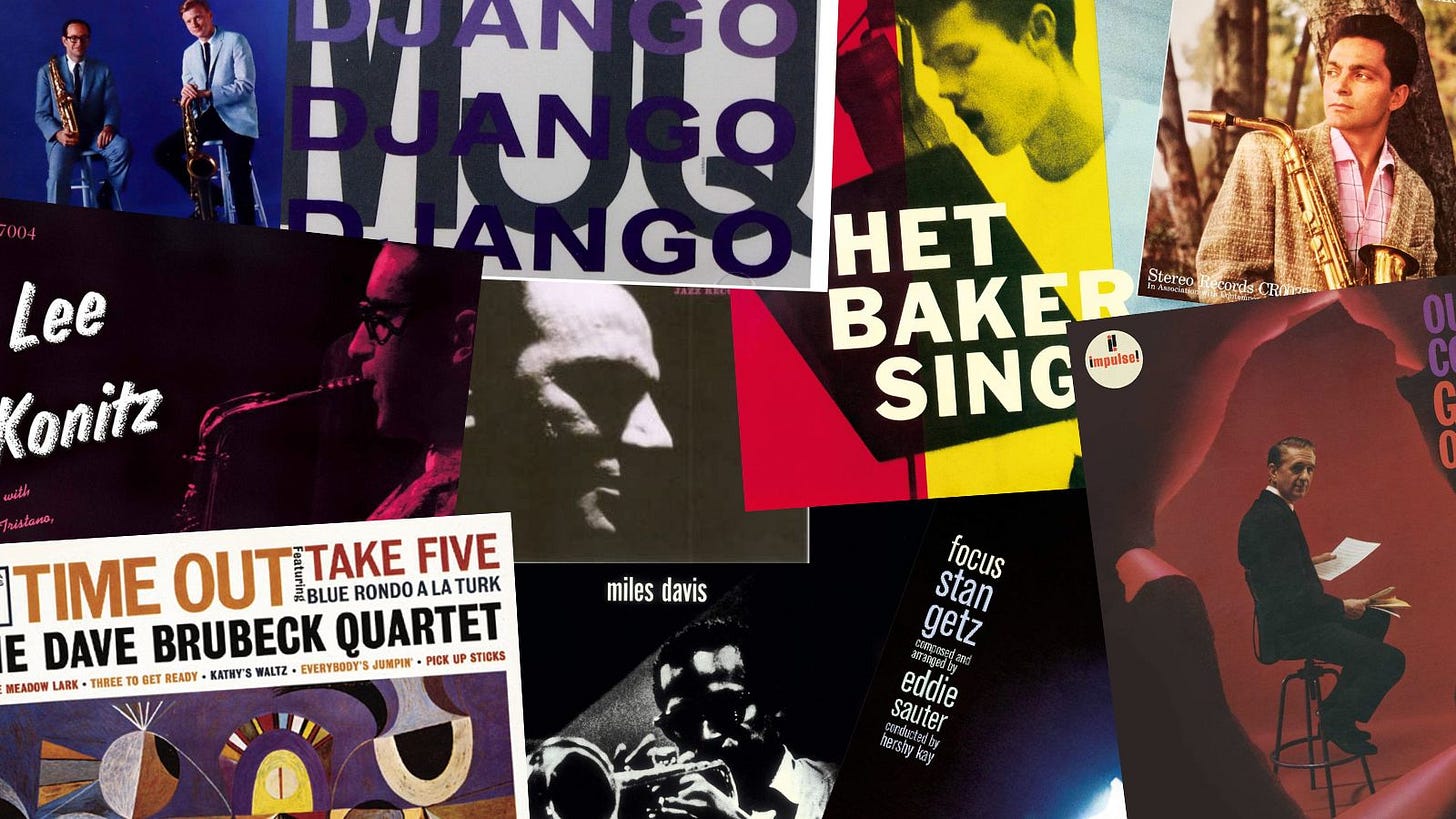10 Essential Cool Jazz Albums
Discover the art of subtlety and elegance in jazz with these ten landmark albums.
Cool jazz is a relaxed smooth jazz style that emerged in the late 1940s, emphasizing restraint and subtlety over fast tempos and complex improvisation. Its special quality lies in its minimalist approach, often marked by soft dynamics, light tone and a focus on lyrical expression.
Here are ten essential cool jazz albums that you need to know about.
10) Lee Konitz, Subconscious-Lee (1955, Prestige/OJC)
Subconscious-Lee is a seminal album highlighting Lee Konitz's distinctive style, marked by its understated linear improvisation. In contrast to bebop’s rapid-fire and often frenetic nature, this album showcases a more lyrical and contemplative approach to jazz. Konitz's playing on the alto saxophone is characterized by a smooth, flowing tone emphasizing melodic development over technical bravado.
9) Gerry Mulligan and Paul Desmond, Two of a Mind (1962, RCA Victor)
Two of a Mind is a remarkable collaborative album that epitomizes the essence of cool jazz through its seamless interplay, lyrical beauty and relaxed, flowing melodies. Mulligan's rich, warm tones blend effortlessly with Desmond's light, airy sound, creating a harmonious dialogue further enhanced by the duo’s intuitive sense of timing and phrasing, allowing them to explore melodic lines with a sense of spontaneity and grace.
8) Stan Getz, Focus (1962, Verve)
Focus is an ambitious and innovative album that marks a significant milestone in Stan Getz's career, blending his lyrical saxophone style with the lush orchestrations of Eddie Sauter. This collaboration results in a captivating fusion of jazz and classical elements, showcasing beauty and complexity, balancing intimate reflection with grand orchestral flourishes.
7) The Gil Evans Orchestra, Out of the Cool (1961, Impulse!)
Gil Evans pushes the boundaries of traditional big band arrangements, creating a unique sound that combines jazz, classical and avant-garde elements to weave a tapestry of sound that evokes a wide range of emotions.
6) Modern Jazz Quartet, Django (1956, Prestige)
Django is an elegant, introspective tribute to the legendary guitarist Django Reinhardt, showcasing the restrained and sophisticated style of the Modern Jazz Quartet, consisting of pianist John Lewis, vibraphonist Milt Jackson, bassist Percy Heath, and drummer Connie Kay. Their interplay is characterized by a refined sense of balance and subtlety, allowing each member to contribute to the overall texture without overpowering one another without disregarding a nuanced attention to detail.
5) Lennie Tristano, Lennie Tristano (1956, Atlantic)
With its emphasis on intellectualism and abstraction, as well as its uses of modern production techniques, this album was deemed controversial upon its original release. Challenging conventional norms and pushing the boundaries of jazz composition and improvisation, the album highlights Lennie Tristano's innovative approach, characterized by meticulous attention to detail and a willingness to experiment with form and rhythm, including unique uses of counterpoint and polyrhythms.
4) Art Pepper, Art Pepper Meets the Rhythm Section (1957, Contemporary)
Art Pepper Meets the Rhythm Section is celebrated for its spontaneous brilliance, capturing the vibrant and impassioned sound of Art Pepper's alto saxophone alongside the legendary rhythm section of Miles Davis. This album features a seamless one-take session that showcases the dynamic interplay between Pepper and the seasoned musicians, including pianist Red Garland, bassist Paul Chambers, and drummer Philly Joe Jones, navigating a variety of moods and tempos, from the lush balladry of "You'd Be So Nice to Come Home To" to the driving energy of "Move."
3) Chet Baker, Chet Baker Sings (1954, Pacific)
Chet Baker Sings is an intimate and melancholic album that redefines the role of the jazz singer through Chet Baker's soft, understated vocal delivery, able to convey deep emotion with a gentle touch, presenting a captivating contrast to the more flamboyant vocal styles often associated with jazz at the time. The album features a selection of standards and ballads, each approached with a sense of vulnerability and sincerity, with Baker accompanied by a stellar ensemble including pianist Russ Freeman.
2) Miles Davis, Birth of the Cool (1957, Capitol)
A landmark compilation of sophisticated and subdued nonet recordings from 1949-1950 that is widely credited with giving birth to the cool jazz movement, showcasing the innovative arrangements and harmonies crafted by Miles Davis and his collaborators, including Gil Evans, who played a crucial role in shaping the sound of this genre. Birth of the Cool features a blend of mellow tones and intricate textures, with the nonet comprising a unique combination of instruments, including trumpets, trombones, French horn, tuba, and a rhythm section. This rich instrumentation creates a distinctive sonic palette, setting it apart from the more aggressive bebop style that preceded it.
1) Dave Brubeck Quartet, Time Out (1959, Columbia)
This groundbreaking recording features the Dave Brubeck Quartet's signature blend of complex time signatures and smooth, polished execution, showcasing their unique ability to push the boundaries of jazz while maintaining an appealing sound. The interplay between the musicians adds depth to the arrangements, creating a cohesive sound while subtly challenging expectations. Fusing innovative spirit with catchy melodies, Time Out became one of the first certified gold jazz records and its reputation is elevated by the iconic "Take Five," penned by saxophonist Paul Desmond.
Follow my music Instagram account!
All my articles are created by me, not AI!




